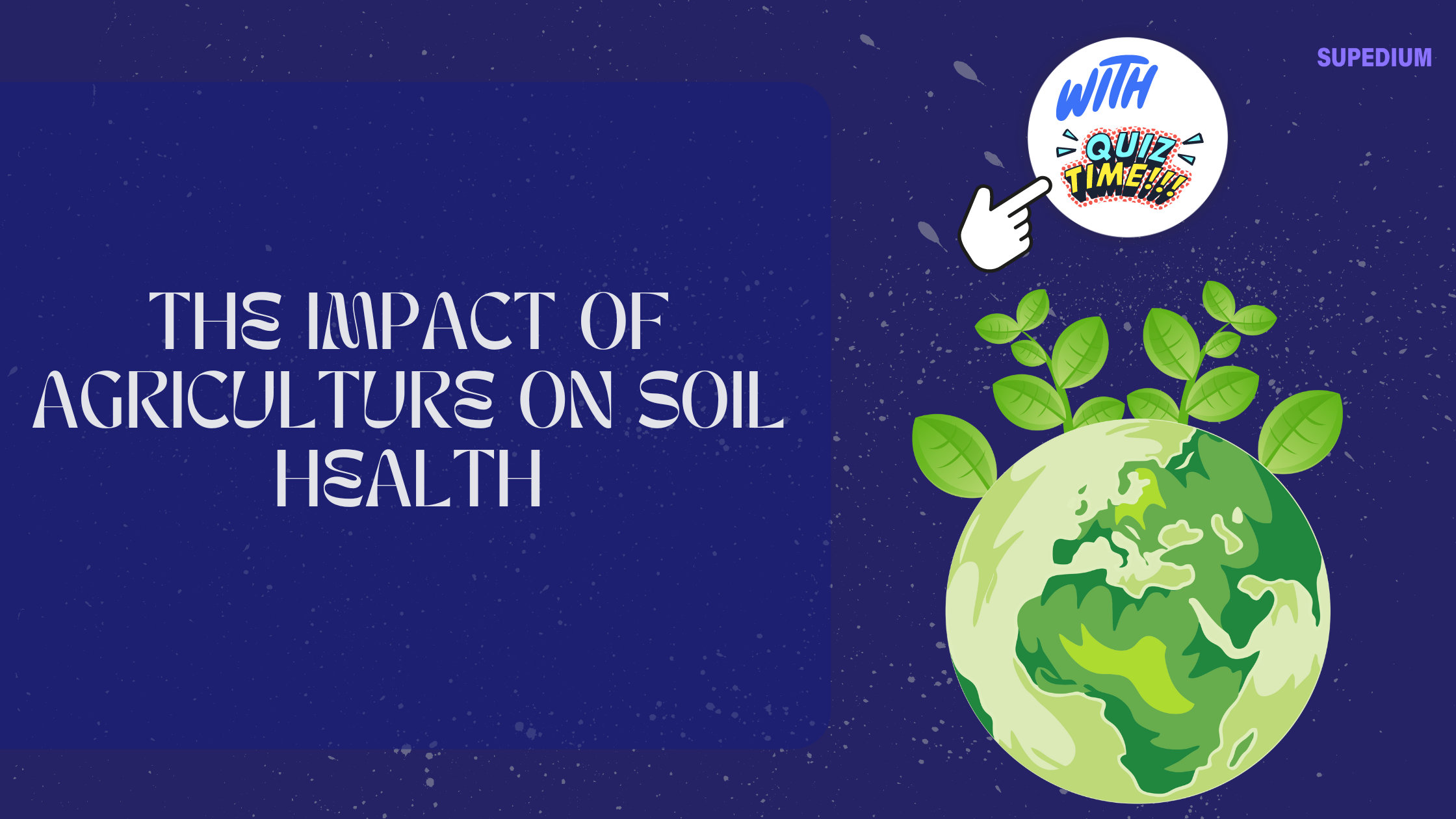Table of Contents
![]()
Introduction
Soil health is a critical aspect of agriculture and environmental sustainability. It encompasses the physical, chemical, and biological properties of soil that affect its ability to support plant growth and maintain ecosystem functions. Healthy soil is essential for productive agriculture, environmental protection, and overall ecological balance. As agricultural practices have evolved, their impact on soil health has become increasingly evident. This article explores how modern agricultural practices affect soil health, the role of sustainable practices in mitigating negative impacts, and the importance of ongoing research and innovation.
Historical Context
Agricultural practices have transformed significantly over the centuries. Traditional methods, such as crop rotation and the use of organic amendments, were designed to maintain soil fertility and health. Crop rotation involves alternating different types of crops in the same field over time, which helps to prevent soil nutrient depletion and manage pests. Organic amendments, such as compost and manure, were commonly used to enhance soil organic matter and fertility.
The Industrial Agricultural Revolution marked a turning point with the introduction of mechanization, synthetic fertilizers, and pesticides. These innovations dramatically increased agricultural productivity but also led to unintended consequences for soil health. The shift towards monoculture, where large areas are planted with a single crop, further impacted soil health by reducing biodiversity and increasing vulnerability to pests and diseases.
Effects of Modern Agricultural Practices on Soil Health
Modern agricultural practices have had profound effects on soil health, many of which are detrimental:
- Soil Erosion Soil erosion is a major concern, primarily driven by practices such as extensive tillage and deforestation. Tillage, or the preparation of soil for planting by mechanically stirring it, can lead to the removal of the topsoil layer, which is rich in nutrients and organic matter. Erosion reduces soil fertility and affects water retention, leading to decreased agricultural productivity and increased sedimentation in waterways.
- Soil Compaction The use of heavy machinery and overgrazing can cause soil compaction, where soil particles are pressed together, reducing pore space. Compacted soil impairs root growth, limits water infiltration, and decreases the soil’s ability to support healthy plant life. This can lead to increased runoff and erosion.
- Nutrient Depletion Intensive farming and over-reliance on synthetic fertilizers can lead to nutrient imbalances and depletion. Synthetic fertilizers often provide a limited range of nutrients, which can disrupt the natural nutrient cycling in soil. Continuous cropping without adequate nutrient replenishment can deplete essential soil nutrients, affecting soil fertility and plant health.
- Soil Acidification The excessive use of nitrogen-based fertilizers contributes to soil acidification, where the soil pH decreases. Acidic soils can reduce the availability of essential nutrients, such as calcium and magnesium, and negatively impact soil microorganisms and plant growth.
- Loss of Soil Organic Matter Modern farming practices, including continuous cropping and intensive tillage, can lead to a decline in soil organic matter. Organic matter is crucial for maintaining soil structure, water-holding capacity, and microbial activity. Its reduction can result in poorer soil quality and decreased agricultural productivity.
- Pesticide and Herbicide Effects The application of pesticides and herbicides can adversely affect soil microbial communities. These chemicals can alter microbial populations, reduce biodiversity, and disrupt soil functions such as nutrient cycling. Additionally, there is a risk of chemical accumulation in the soil, which can have long-term environmental and health impacts.
Sustainable Agricultural Practices and Soil Health
In response to the negative impacts of modern agriculture, sustainable practices have been developed to improve soil health and reduce environmental harm:
- Conservation Tillage Conservation tillage practices, such as no-till and reduced-till methods, aim to minimize soil disturbance. No-till farming involves leaving the soil undisturbed while planting crops directly into the previous crop’s residue. This practice helps to reduce erosion, improve soil structure, and enhance organic matter retention.
- Crop Rotation and Diversity Implementing crop rotation and diversifying cropping systems can enhance soil health. Rotating different crops helps to balance nutrient use, manage pests and diseases, and improve soil structure. Diverse cropping systems promote microbial diversity and enhance soil resilience.
- Organic Farming Organic farming emphasizes the use of organic fertilizers, compost, and natural pest control methods. Organic amendments improve soil organic matter, enhance microbial activity, and contribute to a more balanced soil nutrient profile. Organic farming practices also reduce the reliance on synthetic chemicals.
- Agroforestry Agroforestry integrates trees and shrubs into agricultural landscapes. This practice benefits soil health by reducing erosion, improving soil structure, and enhancing nutrient cycling. Trees also provide additional benefits such as habitat for wildlife and carbon sequestration.
- Cover Crops Planting cover crops, such as legumes and grasses, during non-cropping periods helps to protect and improve soil health. Cover crops prevent erosion, enhance organic matter content, and can fix nitrogen in the soil, reducing the need for synthetic fertilizers.
Research and Innovations
Ongoing research and technological innovations play a crucial role in advancing soil health management:
- Advances in Soil Health Monitoring New technologies, such as soil sensors and remote sensing, enable precise monitoring of soil health indicators. These tools provide real-time data on soil properties, allowing for better management decisions and targeted interventions.
- Genetic and Biotechnological Approaches Advances in genetics and biotechnology offer opportunities to develop crops with improved soil interactions. Research into soil microbes and their roles in nutrient cycling can lead to the development of microbial inoculants that enhance soil health.
- Policy and Education Effective policies and educational programs are essential for promoting sustainable agricultural practices. Government initiatives and regulations can support soil health conservation, while farmer training and education programs can provide knowledge and resources for adopting best practices.
Case Studies
- Success Stories in Soil Health Improvement Various farms and regions have successfully implemented practices to improve soil health. For example, a farm in the Midwest United States adopted no-till practices and cover cropping, resulting in improved soil structure, reduced erosion, and increased crop yields. Another example is a region in Australia where agroforestry and organic farming practices have restored degraded soils and enhanced biodiversity.
- Challenges and Lessons Learned Some soil health initiatives have faced challenges, such as limited resources, lack of knowledge, or resistance to change. For instance, a project aimed at promoting organic farming in a developing country encountered difficulties due to inadequate access to organic inputs and training. Lessons learned from these experiences can guide future efforts and highlight the need for tailored solutions and support.
Conclusion
The impact of agriculture on soil health is profound and multifaceted. Modern agricultural practices have led to significant challenges, including soil erosion, compaction, nutrient depletion, and loss of organic matter. However, sustainable practices such as conservation tillage, crop rotation, organic farming, agroforestry, and cover cropping offer promising solutions to mitigate these impacts and improve soil health.
Ongoing research, technological innovations, and effective policies are crucial for advancing soil health management. By adopting sustainable practices and supporting research and education, we can ensure the long-term health and productivity of our soils, benefiting agriculture, ecosystems, and future generations.
As we move forward, it is essential to continue exploring and implementing solutions that enhance soil health and promote sustainable agricultural practices. The future of agriculture depends on our ability to balance productivity with environmental stewardship, ensuring that soil remains a vital and healthy resource for years to come.






Be the first to comment